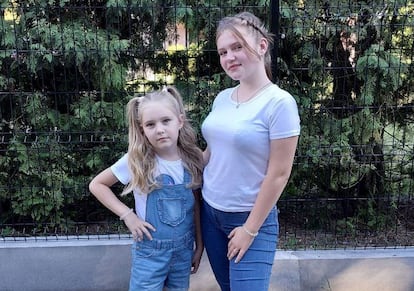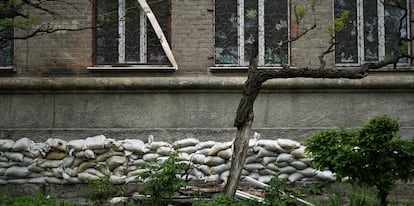Zoom classes between artillery bombardments at the gates of Bakhmut
Over a year after the Russian invasion of Ukraine, girls like Diana and Yuliana are still unable to return to normality, confined to their home in the front line city of Kostiantynivka
Diana and Yuliana were awakened at 5 a.m. on February 24, 2022 by the sound of loud explosions. Diana was 15 years old and knew instantly that the war had started, that Russia was invading Ukraine. Her sister Yuliana was eight and didn’t understand what was happening. “I just got really scared,” she recalls more than a year later. Their life as children changed completely. They stopped going to school. Again. They went almost directly from the restrictions caused by the coronavirus pandemic to those imposed by war, to connecting to an online class amid the noise of missiles, mortars, howitzers, machine guns, sirens, anti-aircraft defenses and tanks roaming the streets of their city. The sisters live in Kostiantynivka, 10 kilometers (six miles) from the hell of the Bakhmut front. There are many days when they aren’t even able to leave the house.
The nights and days have turned into almost identical time sequences over the weeks and months. Waking up. Logging on to Zoom for classes. Studying. Eating. In the afternoon, Yuliana plays a little and, if there are no explosions, heads out down the street for a while with her mother and a friend. Diana chats with her friends online, scans Telegram, Instagram, TikTok and does some exercise indoors. They eat dinner. They go to bed. They pray the night will be a quiet one. And then it’s back to square one.

Days without leaving the house
Kostiantynivka, which had a pre-war population of around 70,000 inhabitants, is fewer than 70 kilometers (43 miles) from Donetsk and has suffered constant bombardment since the beginning of the invasion. This is the not the first time the city has been under attack: German troops left it in ruins after their retreat at the end of World War II. And in 2014, when Moscow launched its assault on the Donbas region, it was briefly under the occupation of pro-Russian separatists before Ukrainian forces retook the city. Now it is once again the target of heavy shelling.
“Many days can go by without me leaving the house,” says Diana, a quiet, thoughtful teenager with long blonde hair. “The explosions are getting closer and louder. There was a time when we got used to hearing them in the background, but now they happen all the time and they are very bad.” Yuliana thought that everything would last two or three months at the most, but the war shows no sign of ending and over the last month the attacks on Kostiantynivka have intensified. Children and adults have become experts in detecting whether a shell is outgoing or incoming, and whether an explosion has come from a missile, a drone, artillery, or gunfire.

Diana’s Zoom class is usually attended by only around half of her schoolmates. Some don’t log in because they have been kept up all night by artillery or missile attacks and use the morning to sleep. Others have no light, or have decided not to attend classes and only do their homework. The school building itself is bombed out and abandoned. Many teachers are continuing to teach their students from Kyiv, Lviv or even from another country. They left out of fear, for themselves and for their families, but they remain committed to their work and helping their students as much as they can.
Language teacher Anna Korotkiya — from the devastated village of Kamianka, but who now lives in the Poltava region and teaches online classes to students in Izium — tells the same story as Diana. “There are some children I don’t even know where they are, others don’t have internet, and there are those who tell you straight away that they need a psychologist, that they need help, because they can’t take it anymore. And then there are the kids who were my students until recently and who I know are now fighting in the war. It’s all very difficult to take on board.”
Diana and Yuliana left the country for a few months with their mother. From April to November 2022, they lived in a city near Krakow in Poland, but attended their Ukrainian classes online. Then they returned to Kostiantynivka. “My husband had stayed here and I also felt that I had to return to my town and contribute to the continuation of life in the community,” says the girls’ mother, 37-year-old Yulia Krivosheyeva. “We needed to be all together again.”
There are the kids who were my students until recently and who I know are now fighting in the war”Anna Korotkiya, teacher
Yulia works in a pastry shop in the center of Kostiantynivka. She delivers apple pies, traditional Kharkiv and Donetsk cakes, banana cream-filled buns, cookies, pies, pizzas and 12 different types of bread. Bakers and pastry chefs work in shifts, 24 hours a day. As there is always someone inside the shop, even if it is closed, soldiers returning from the Bakhmut front often come by in the evening for a bite to eat.
Kostiantynivka serves as a base for the Ukrainian Armed Forces. The city is in a strategic position between the Bakhmut and Avdiivka fronts, the two most active battlefields of the war. When soldiers on the front line rotate for a few days, they do so in Kostiantynivka. Supplies for troops coming from the west, from Kramatorsk, inevitably pass through the town, making it a clear target for Russian forces. Every building in Kostiantynivka is within range of their artillery.

Normality amid the devastation
Next door to Yulia’s cozy pastry shop, as a further contrast between normality and the devastation of war, is an imposing building that has been bombed out, a cultural center built in 1976, when Ukraine was part of the Soviet Union. A year and a half ago it staged plays and concerts and offered art and dance classes to children. It was hit on Valentine’s Day, February 14, and now there is nothing left beyond rubble piled in front of its door and shattered windows covered with metal and wood.
As is the case throughout Ukraine, the streets of Kostiantynivka are lined with giant posters encouraging enlistment: “Let’s defend Ukraine together,” reads the slogan. The city’s hospital has gone from treating sick civilians to patching up wounded soldiers and residents. “The hardest thing about the war has been seeing wounded children,” says chief surgeon Yurii Mishastii, 63. “We treated a one-year-old baby. We stabilized him and took him to Dnipro. The family was driving out of Bakhmut when the mother, father and son were shot. There are also teenagers with serious injuries. It is difficult.”
Children, teenagers, young people… I think at the moment they don’t fully understand what we are living through. Awareness will come in the future”Yuri Mishati, chief surgeon at Kostiantynivka Hospital
Children and teenagers in Kostiantynivka and other municipalities near the front lines have been living permanently for over a year among death, wounds, missiles, fear, and anxiety, often without gas, electricity or running water for months on end. “The war is a great challenge for this generation”, says Mishastii. “Children, teenagers, young people… I think at the moment they don’t fully understand what we are living through. Awareness will come in the future.”
“The situation is very complicated,” Yulia says. “We are more and more afraid. And the children can’t stay here.” Her husband will remain in Kostiantynivka, but she has decided to move to Kyiv with Diana and Yuliana. She hopes, like everyone else, that the Ukrainian counteroffensive will be successful, that the Russians will withdraw, that the war will end, that she will be able to return at some point to her home, her shop, and the reassuring routines of life in peace.
Credits
Follow all the international news on Facebook and Twitter, or on our weekly newsletter.